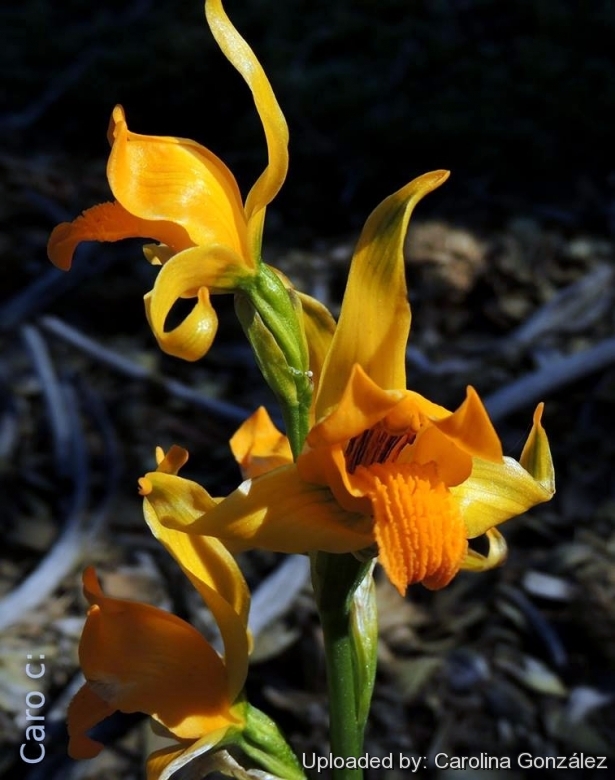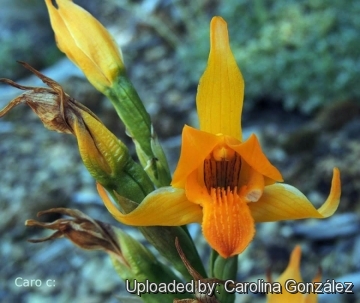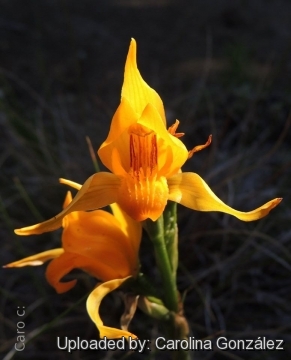Accepted Scientific Name: Chloraea alpina Poepp.
Fragm. Syn. Pl. 17 1833. Poepp.

Asarca alpina (Chloraea alpina) Photo by: Carolina González
Origin and Habitat: Argentina (Patagonia) and Chile.
Altitude range: From the central cordilleras at 1500-2000m to arid southeastern Patagonia at up to 50 m.
Habitat and ecology: Chloraea alpinaSN|32165]]SN|32165]] occours in coastal mountains, low interior valleys and in medium to high altitude close to the timber line. It is found in humid to dry, sheltered rocky slopes and hollows, volcanic sand fields and bunch-grass clearings in woodland or dried forest areas where the drought may last 1 to 5 months. Precipitations of 400 - 800 mm per annum are concentrated in winter.
Synonyms:
See all synonyms of Chloraea alpina
back
Accepted name in llifle Database:Chloraea alpina Poepp.Fragm. Syn. Pl. 17 1833.Synonymy: 7
back
Common Names include:
SPANISH (Español): Azucena del campo, Tulipan del campo, Tulipan del monte, Orquídea, Orquídea de flor dorada, Tulipán del monte
Description: Chloraea alpinaSN|32165]]SN|32165]] is a lovely, medium-sized, stoutly erect, herbaceous, terrestrial orchid sometimes forming clumps 30-50 cm tall with fleshy roots, and lance-shaped leaves along the stem. It has yellow-orange flowers with 6 petals, the 3 outer ones called tepals and 3 inner petals streaked with purple. Chloraea alpinaSN|32165]]SN|32165]] was described by Friedrich Eduard Fragmentum Poeppig in Fragmentum Synopseos Plantarum Phanerogamum 17. 1833.
Derivation of specific name: Alpinus,-a,-um; from L. alpinus (from L. Alpes, the Alps), of he Alps, growing in the Alps, by extension growing in high mountainous.
Leaves: Basal leaves 5 - 6, sessile, glabrous, oblong, acute, conduplicate, persisting during flowering 10 or more cm long, with a sheathing base 1,3-2 cm wide. Cauline leaves distributed up the stems, shorter, thinner, lanceolate, acuminate, bract-like.
Roots: Tuberous.
Inflorescence: Terminal, erect. Scape 20-40(-50) cm tall (mostly shorter than basal leaves) with loose spikes of three to six flowers. Bracts oblong acute longer than ovaries mostly 8-5 cm long.
Flowers: Flowers waxy deep yellow or orange to 6 cm across (occasionally white streaked with green). Dorsal sepal ovate-triangular sharp, lateral sepals similar but smaller narrower, thickened , all the apex obtuse. Perianth yellow, lip heart-shaped, reticulate sometime streaked with purple at the base, 3-lobed in the tip, about 2 cm long and 1.3 cm wide, with the outer lobes hemispherical, the central one rounded and the margins incurled, usually entire, but sometimes slightly crenellated.
Blooming season: It blooms in early in the spring (mostly November to January in the wild.)
Bibliography: Major references and further lectures
1) Florence Woodgate Konczewska “Argentine flowers” Albatros, 1976
2) “Anales de la Universidad de Chile” Imprenta del Siglo, 1922
3) Correa, M.N. 1969. “Chloraea, género sudamericano de Orchidaceae.” Darwiniana 15: 374–500.
4) Correa, M.N. 1969. “Orchidaceae”, In: M. N. Correa (ed.),. 8(2): 188–209. In M.N. Correa (ed.) Fl. Patagónica. Instituto Nacional de Tecnología Agropecuaria, Buenos Aires.
5) Hauman, L. 1921. “Anales Soc. Ci. Argent.” 90: 111. View in Biodiversity Heritage Library
6) Kraenzlin, F. W. L. 1904. “Orchid.” Gen. Sp. 2: 33.
7) Marticorena, C. & M. Quezada. 1985. “Catálogo de la Flora Vascular de Chile”. Gayana, Bot. 42: 1–157.
8) Skottsberg, C. 1916. WKungl. “Svenska Vetenskapsakad. Handl.” Ser. III 56(5): 196.
9) Zuloaga, F. O., O. N. Morrone, M. J. Belgrano, C. Marticorena & E. Marchesi. (eds.) 2008. “Catálogo de las plantas vasculares del Cono Sur.” Monogr. Syst. Bot. Missouri Bot. Gard. 107: 3 Vols., 3348 p.
10) “Chloraea alpina” - The Alpine Garden Society <http://encyclopaedia.alpinegardensociety.net/plants/Chloraea/alpina> web 30 December 2015
 Asarca alpina (Chloraea alpina) Photo by: Carolina González
Asarca alpina (Chloraea alpina) Photo by: Carolina González Asarca alpina (Chloraea alpina) Photo by: Carolina González
Asarca alpina (Chloraea alpina) Photo by: Carolina González










